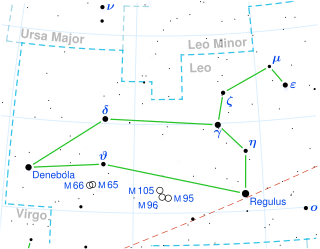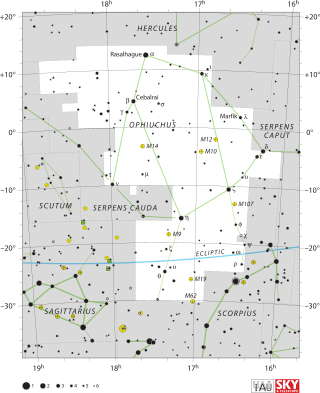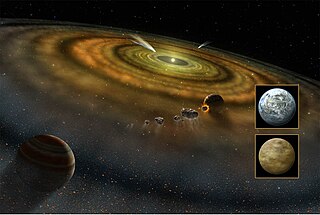Related Research Articles

Beta Pictoris is the second brightest star in the constellation Pictor. It is located 63.4 light-years (19.4 pc) from the Solar System, and is 1.75 times as massive and 8.7 times as luminous as the Sun. The Beta Pictoris system is very young, only 20 to 26 million years old, although it is already in the main sequence stage of its evolution. Beta Pictoris is the title member of the Beta Pictoris moving group, an association of young stars which share the same motion through space and have the same age.

Denebola is the second-brightest star in the zodiac constellation of Leo. It is the easternmost of the bright stars of Leo. It has the Bayer designation Beta Leonis or β Leonis, which are abbreviated Beta Leo or β Leo. Denebola is an A-type main sequence star with 75% more mass than the Sun and 15 times the Sun's luminosity. Based on parallax measurements from the Hipparcos astrometry satellite, the star is at a distance of 36 light-years from the Sun. Its apparent visual magnitude is 2.14, making it readily visible to the naked eye. Denebola is a Delta Scuti type variable star, meaning its luminosity varies very slightly over a period of a few hours.

AU Microscopii is a young red dwarf star located 31.7 light-years away – about 8 times as far as the closest star after the Sun. The apparent visual magnitude of AU Microscopii is 8.73, which is too dim to be seen with the naked eye. It was given this designation because it is in the southern constellation Microscopium and is a variable star. Like β Pictoris, AU Microscopii has a circumstellar disk of dust known as a debris disk and at least two exoplanets, with the presence of an additional two planets being likely.
HD 210277 is a single star in the equatorial constellation of Aquarius. It has an apparent visual magnitude of 6.54, which makes it a challenge to view with the naked eye, but it is easily visible in binoculars. The star is located at a distance of 69.5 light years from the Sun based on parallax, but is drifting closer with a radial velocity of −20.9 km/s.

Beta Ophiuchi or β Ophiuchi, also named Cebalrai, is a star in the equatorial constellation of Ophiuchus. The apparent visual magnitude of this star is 2.7, which is readily visible to the naked eye even from urban skies. The distance to this star can be estimated using parallax measurements, yielding a value of 81.8 light-years from the Sun.

Epsilon Serpentis, Latinized from ε Serpentis, is a single, white-hued star in the constellation Serpens, in its head. It is visible to the naked eye with an apparent visual magnitude of +3.69. Based upon an annual parallax shift of 46.30 mas as seen from Earth, it is located 70 light years from the Sun. It is moving closer to the Sun with a radial velocity of −9 km/s.
Eta Telescopii is a white-hued star in the southern constellation of Telescopium. This is an A-type main sequence star with an apparent visual magnitude of +5.03. It is approximately 158 light years from Earth and is a member of the Beta Pictoris Moving Group of stars that share a common motion through space. It is moving through the Galaxy at a speed of 23.7 km/s relative to the Sun.

Beta Trianguli Australis, Latinized from β Trianguli Australis, is a double star in the southern constellation of Triangulum Australe. It is approximately 40.37 light-years from Earth and has an apparent visual magnitude of +2.85. This star has a relatively high rate of proper motion across the celestial sphere. It is a F-type main-sequence star with a stellar classification of F1 V. Beta TrA has a 14th magnitude optical companion at an angular separation of 155 arcseconds.

Gamma Trianguli Australis, Latinized from γ Trianguli Australis, is a single, white-hued star in the southern constellation of Triangulum Australe. Along with Alpha and Beta Trianguli Australis it forms a prominent triangular asterism that gives the constellation its name. It is the third-brightest member of this constellation with an apparent visual magnitude of +2.87. Based upon parallax measurements, Gamma Trianguli Australis is located at a distance of about 184 light-years from Earth.
Chi Boötis, Latinised as χ Boötis, is a single, white-hued star in the northern constellation Boötes, near the eastern constellation border with Corona Borealis. It is faintly visible to the naked eye with an apparent visual magnitude of +5.3. Based upon an annual parallax shift of 13.0 mas as seen from the Earth, it is located about 251 light-years from the Sun. The star is moving closer to the Sun with a radial velocity of −16 km/s.

Alpha Pictoris is the brightest star in the southern constellation of Pictor. It has an apparent visual magnitude of 3.27, which is bright enough to be viewed from urban areas in the southern hemisphere. This star is close enough for its distance to be measured using parallax shifts, which yields a value of roughly 97 light-years from the Sun, with a 5% margin of error. Alpha Pictoris has the distinction of being the south pole star of the planet Mercury.

A debris disk, or debris disc, is a circumstellar disk of dust and debris in orbit around a star. Sometimes these disks contain prominent rings, as seen in the image of Fomalhaut on the right. Debris disks are found around stars with mature planetary systems, including at least one debris disk in orbit around an evolved neutron star. Debris disks can also be produced and maintained as the remnants of collisions between planetesimals, otherwise known as asteroids and comets.

Gamma Ophiuchi, Latinized from γ Ophiuchi, is a fourth-magnitude star in the constellation Ophiuchus. Together with Beta Ophiuchi, it forms the serpent-holder's right shoulder. The staris visible to the naked eye with an apparent visual magnitude of +3.75. Based upon an annual parallax shift of 31.73 mas as seen from Earth, it is located 103 light years from the Sun. It is moving closer to the Sun with a radial velocity of −7.6 km/s.

HD 15115 is a single star in the equatorial constellation of Cetus. It is readily visible in binoculars or a small telescope, but is considered too dim to be seen with the naked eye at an apparent visual magnitude of 6.76. The distance to this object is 160 light years based on parallax, and it is slowly drifting further away at the rate of about 1 km/s. It has been proposed as a member of the Beta Pictoris moving group or the Tucana-Horologium association of co-moving stars; there is some ambiguity as to its true membership.

Beta Pictoris b (abbreviated as β Pic b) is an exoplanet orbiting the young debris disk A-type main sequence star Beta Pictoris located approximately 63 light-years (19.4 parsecs, or 6×1014 km) away from Earth in the constellation of Pictor. It has a mass around 13 Jupiter masses and a radius around 46% larger than Jupiter's. It orbits at 9 AU from Beta Pictoris, which is about 3.5 times farther than the orbit of Beta Pictoris c. It orbits close to the plane of the debris disk orbiting the star, with a low eccentricity and a period of 20–21 years.

HD 172555 is a white-hot Type A7V star located relatively close by, 95 light years from Earth in the direction of the constellation Pavo. Spectrographic evidence indicates a relatively recent collision between two planet-sized bodies that destroyed the smaller of the two, which had been at least the size of the Moon, and severely damaged the larger one, which was at least the size of Mercury. Evidence of the collision was detected by NASA's Spitzer Space Telescope.

66 Ophiuchi is a binary variable star in the equatorial constellation of Ophiuchus. It has the variable star designation V2048 Ophiuchi, while 66 Ophiuchi is the Flamsteed designation. This object is visible to the naked eye as a faint, blue-white hued point of light with a baseline apparent visual magnitude of 4.60. It is located approximately 650 light years away from the Sun based on parallax, but is drifting closer with a radial velocity of −13 km/s. The star has a peculiar velocity of 13.1±3.2 km/s relative to its neighbors.

An exocomet, or extrasolar comet, is a comet outside the Solar System, which includes rogue comets and comets that orbit stars other than the Sun. The first exocomets were detected in 1987 around Beta Pictoris, a very young A-type main-sequence star. There are now a total of 27 stars around which exocomets have been observed or suspected.
HD 146624 is a single, white-hued star in the southern zodiac constellation of Scorpius. It is faintly visible to the naked eye, having an apparent visual magnitude of 4.80. The distance to HD 146624 can be estimated from its annual parallax shift of 23.0 mas, yielding a separation of 142 light years. At that distance, the visual magnitude is reduced by an extinction of 0.17 due to interstellar dust. It is a member of the Beta Pictoris moving group, a set of ~12 million year old stars that share a common motion through space.
HD 256 is a binary star system in the equatorial constellation of Cetus. It has a white hue and is dimly visible to the naked eye with an apparent visual magnitude of 6.20. Based upon parallax measurements, the system is located at a distance of approximately 474 light years from the Sun. It is drifting closer with a radial velocity of −10 km/s.
References
- 1 2 3 4 5 6 van Leeuwen, F. (November 2007), "Validation of the new Hipparcos reduction", Astronomy and Astrophysics, 474 (2): 653–664, arXiv: 0708.1752 , Bibcode:2007A&A...474..653V, doi:10.1051/0004-6361:20078357, S2CID 18759600
- 1 2 3 4 Johnson, H. L.; et al. (1966). "UBVRIJKL photometry of the bright stars". Communications of the Lunar and Planetary Laboratory. 4 (99): 99. Bibcode:1966CoLPL...4...99J.
- ↑ Manoj, P.; et al. (December 2006), "Evolution of Emission-Line Activity in Intermediate-Mass Young Stars", The Astrophysical Journal, 653 (1): 657–674, arXiv: astro-ph/0608541 , Bibcode:2006ApJ...653..657M, doi:10.1086/508764, S2CID 17545474
- 1 2 Evans, D. S. (June 20–24, 1966), "The Revision of the General Catalogue of Radial Velocities", in Batten, Alan Henry; Heard, John Frederick (eds.), Determination of Radial Velocities and their Applications, Proceedings from IAU Symposium, vol. 30, University of Toronto: International Astronomical Union, p. 57, Bibcode:1967IAUS...30...57E
- 1 2 3 4 Jamialahmadi, N.; et al. (July 2015). "The peculiar fast-rotating star 51 Ophiuchi probed by VEGA/CHARA". Astronomy & Astrophysics. 579: 4. arXiv: 1709.04872 . Bibcode:2015A&A...579A..81J. doi:10.1051/0004-6361/201425473. S2CID 6213084. A81.
- 1 2 3 4 5 Saffe, C.; et al. (October 2008), "Spectroscopic metallicities of Vega-like stars", Astronomy and Astrophysics, 490 (1): 297–305, arXiv: 0805.3936 , Bibcode:2008A&A...490..297S, doi:10.1051/0004-6361:200810260, S2CID 15059920
- 1 2 Dunkin, S. K.; Barlow, M. J.; Ryan, Sean G. (April 1997), "High-resolution spectroscopy of Vega-like stars - I. Effective temperatures, gravities and photospheric abundances", Monthly Notices of the Royal Astronomical Society , 286 (3): 604–616, Bibcode:1997MNRAS.286..604D, doi: 10.1093/mnras/286.3.604
- 1 2 3 Roberge, A.; et al. (March 2002). "Far Ultraviolet Spectroscopic Explorer Observations of Possible Infalling Planetesimals in the 51 Ophiuchi Circumstellar Disk". The Astrophysical Journal. 568 (1): 343–351. arXiv: astro-ph/0111154 . Bibcode:2002ApJ...568..343R. doi:10.1086/338877. S2CID 15321298.
- ↑ "c Oph". SIMBAD . Centre de données astronomiques de Strasbourg . Retrieved 2019-06-22.
- 1 2 3 "Twin Keck telescopes probe dual dust disks", e! Science News, September 24, 2009, retrieved 2009-10-01
- ↑ Berthoud, M. G.; et al. (May 2007), "Near-IR CO Overtone Emission in 51 Ophiuchi", The Astrophysical Journal, 660 (1): 461–468, Bibcode:2007ApJ...660..461B, doi: 10.1086/512056
- 1 2 Stark, Christopher C.; et al. (2009), "51 Ophiuchus: A Possible Beta Pictoris Analog Measured with the Keck Interferometer Nuller", Astrophysical Journal , 703 (2): 1188–1197, arXiv: 0909.1821 , Bibcode:2009ApJ...703.1188S, doi:10.1088/0004-637X/703/2/1188, S2CID 17938884
- ↑ Smith, B. A.; Terrile, R. J. (1984), "A circumstellar disk around Beta Pictoris", Science , 226 (4681): 1421–1424, Bibcode:1984Sci...226.1421S, doi:10.1126/science.226.4681.1421, PMID 17788996, S2CID 120412113
- ↑ Jenkins, Edward B.; Gry, Cecile (2020). "The Composition, Excitation, and Physical State of Atomic Gas in the Debris Disk Surrounding 51 Oph". Astrophysical Journal. 896 (1): 24. arXiv: 2004.10238 . Bibcode:2020ApJ...896...24J. doi: 10.3847/1538-4357/ab8bdd . S2CID 216056466.